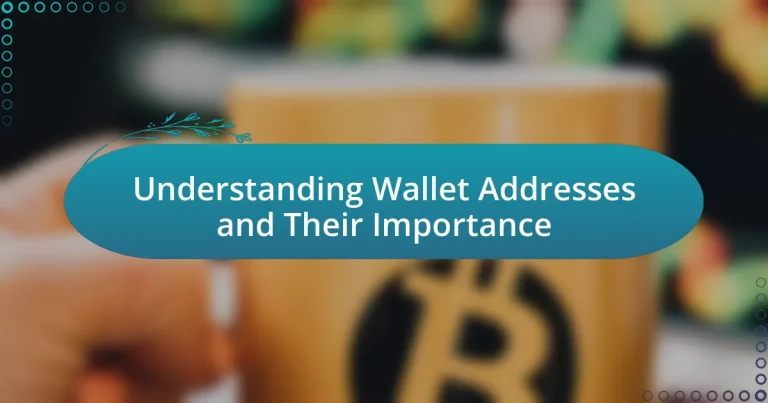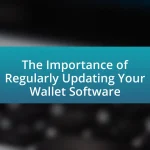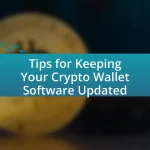Wallet addresses are unique identifiers in cryptocurrency networks that enable the secure sending and receiving of digital assets. This article provides an in-depth exploration of wallet addresses, detailing their generation through cryptographic algorithms, the role of private and public keys, and the various types of addresses used across different cryptocurrencies. It also discusses the importance of wallet addresses in transactions, the security measures associated with them, and best practices for users to manage and protect their wallet addresses effectively. Additionally, the article highlights the risks involved, including potential exposure to theft and privacy concerns, and offers guidance on how to mitigate these risks.

What are Wallet Addresses?
Wallet addresses are unique identifiers used in cryptocurrency networks to facilitate the sending and receiving of digital assets. Each wallet address corresponds to a specific wallet, which stores the user’s private and public keys, enabling transactions on the blockchain. For example, Bitcoin wallet addresses are typically represented as a string of alphanumeric characters, allowing users to securely transact without revealing their identity. This system ensures that funds can be directed to the correct recipient while maintaining a level of anonymity and security inherent to blockchain technology.
How are Wallet Addresses generated?
Wallet addresses are generated through a process that involves cryptographic algorithms and public key cryptography. Initially, a user creates a private key, which is a randomly generated number. This private key is then used to generate a corresponding public key through elliptic curve multiplication, a mathematical operation that is computationally infeasible to reverse. Finally, the wallet address is derived from the public key using a hashing algorithm, such as SHA-256 followed by RIPEMD-160, which produces a shorter, fixed-length address that can be easily shared and used for transactions. This method ensures that wallet addresses are unique and secure, making it extremely difficult for anyone to derive the private key from the wallet address.
What algorithms are used in the generation of Wallet Addresses?
Wallet addresses are generated using algorithms such as SHA-256 and RIPEMD-160. These algorithms are integral to the process of creating secure and unique wallet addresses in cryptocurrencies. Specifically, SHA-256 is used to hash the public key, producing a fixed-size output, while RIPEMD-160 further hashes the output of SHA-256 to create a shorter, more manageable address. This two-step hashing process enhances security by making it computationally infeasible to reverse-engineer the original public key from the wallet address.
What role do private and public keys play in Wallet Address generation?
Private and public keys are essential in wallet address generation as they create a secure cryptographic framework for transactions. The public key is derived from the private key through a mathematical process, allowing it to serve as an address that others can use to send cryptocurrency. The private key, on the other hand, is kept secret and is used to sign transactions, proving ownership of the associated wallet address. This relationship ensures that only the holder of the private key can access and manage the funds linked to the public address, thereby maintaining security and integrity in cryptocurrency transactions.
What types of Wallet Addresses exist?
There are several types of wallet addresses that exist in the cryptocurrency ecosystem, primarily including Bitcoin addresses, Ethereum addresses, and multi-signature addresses. Bitcoin addresses can be categorized into three formats: P2PKH (Pay-to-Public-Key-Hash), P2SH (Pay-to-Script-Hash), and Bech32 (native SegWit addresses). Ethereum addresses are typically represented as hexadecimal strings starting with ‘0x’. Multi-signature addresses require multiple private keys to authorize a transaction, enhancing security. Each type serves distinct purposes and adheres to specific protocols, ensuring compatibility within their respective networks.
What distinguishes a Bitcoin Wallet Address from an Ethereum Wallet Address?
A Bitcoin wallet address is distinguished from an Ethereum wallet address primarily by its format and the underlying blockchain technology. Bitcoin addresses typically start with a ‘1’, ‘3’, or ‘bc1’ and are 26 to 35 characters long, while Ethereum addresses begin with ‘0x’ followed by 40 hexadecimal characters. This difference in structure reflects the distinct protocols and address generation methods used by each cryptocurrency. Bitcoin utilizes a UTXO (Unspent Transaction Output) model, whereas Ethereum employs an account-based model, which further influences how transactions are processed and recorded on their respective blockchains.
How do hierarchical deterministic (HD) Wallet Addresses differ from non-HD Wallet Addresses?
Hierarchical deterministic (HD) wallet addresses differ from non-HD wallet addresses primarily in their structure and management of keys. HD wallets generate a tree-like structure of keys from a single seed phrase, allowing for the creation of multiple addresses that can be derived in a predictable manner, which enhances privacy and organization. In contrast, non-HD wallets typically generate each address independently, requiring separate backups for each key and making it more challenging to manage multiple addresses. This distinction is significant as HD wallets simplify the backup process and improve user experience by allowing users to recover all derived addresses from a single seed phrase.
Why are Wallet Addresses important in cryptocurrency transactions?
Wallet addresses are crucial in cryptocurrency transactions because they serve as unique identifiers for sending and receiving digital assets. Each wallet address corresponds to a specific wallet, ensuring that transactions are directed to the correct recipient. This uniqueness prevents errors and fraud, as each address is generated through cryptographic algorithms, making it nearly impossible to duplicate. Additionally, wallet addresses facilitate the tracking of transaction history on the blockchain, providing transparency and security. The importance of wallet addresses is underscored by the fact that without them, the decentralized nature of cryptocurrencies would be compromised, leading to potential loss of funds and lack of accountability in transactions.
How do Wallet Addresses ensure security in transactions?
Wallet addresses ensure security in transactions by providing a unique identifier for each user, which helps prevent unauthorized access and fraud. Each wallet address is generated through cryptographic algorithms, making it extremely difficult to guess or replicate. This cryptographic foundation ensures that only the owner of the private key associated with the wallet address can authorize transactions, thereby safeguarding the funds. Additionally, the use of public and private key pairs in wallet addresses enhances security by allowing users to share their public address for receiving funds while keeping their private key confidential, further reducing the risk of theft or loss.
What risks are associated with using Wallet Addresses?
Using wallet addresses carries several risks, including exposure to theft, loss of funds, and privacy concerns. Wallet addresses can be publicly visible on blockchain networks, making them susceptible to hacking attempts and phishing scams. For instance, if a user shares their wallet address publicly, malicious actors can target them for theft or fraud. Additionally, if a user loses access to their private keys, they may permanently lose access to their funds, as there is no recovery mechanism in most cryptocurrency systems. Privacy is also a significant risk; transactions linked to a wallet address can be traced, potentially revealing the user’s identity and financial activities.

How do Wallet Addresses function in the blockchain ecosystem?
Wallet addresses function as unique identifiers for users in the blockchain ecosystem, enabling the sending and receiving of digital assets. Each wallet address is derived from a public key through cryptographic algorithms, ensuring that it is unique and secure. When a transaction occurs, the wallet address specifies the source and destination of the assets, allowing for transparent and traceable transfers on the blockchain. This functionality is crucial for maintaining the integrity of the decentralized ledger, as it ensures that all transactions are recorded and can be verified by any participant in the network.
What is the process of sending and receiving cryptocurrency using Wallet Addresses?
The process of sending and receiving cryptocurrency using wallet addresses involves generating a unique address for each transaction, which serves as the destination for the funds. When a sender initiates a transaction, they input the recipient’s wallet address and the amount to be sent. The sender’s wallet then creates a digital signature to authorize the transaction, ensuring that only the owner of the funds can send them. This transaction is then broadcasted to the cryptocurrency network, where it is verified by miners or validators.
Once verified, the transaction is added to the blockchain, making it immutable and publicly accessible. The recipient’s wallet address is credited with the amount sent, and the sender’s balance is decreased accordingly. This entire process relies on cryptographic principles to ensure security and integrity, with wallet addresses acting as the key identifiers for each participant in the transaction.
What steps are involved in initiating a transaction with a Wallet Address?
To initiate a transaction with a Wallet Address, the following steps are involved: First, the sender must access their cryptocurrency wallet, which contains their private keys and balance. Next, the sender selects the option to create a new transaction and inputs the recipient’s Wallet Address accurately to ensure the funds are sent to the correct destination. After entering the amount to be transferred, the sender reviews the transaction details for accuracy. Finally, the sender confirms the transaction, which is then signed with their private key and broadcasted to the blockchain network for processing. This process is essential as it ensures the security and integrity of the transaction, preventing unauthorized access to funds.
How does the blockchain verify transactions linked to Wallet Addresses?
The blockchain verifies transactions linked to wallet addresses through a consensus mechanism that ensures all participants in the network agree on the validity of transactions. Each transaction is recorded in a block, which is then added to a chain of previous blocks, creating a permanent and immutable ledger. This process involves cryptographic hashing, where each block contains a unique hash of the previous block, linking them securely. Additionally, nodes in the network validate transactions by checking digital signatures associated with wallet addresses, confirming that the sender has the authority to initiate the transaction. This verification process is crucial for maintaining the integrity and security of the blockchain, as it prevents double-spending and unauthorized transactions.
What are the implications of Wallet Address privacy?
Wallet address privacy has significant implications for user security and financial autonomy in the cryptocurrency ecosystem. When wallet addresses are kept private, it protects users from potential hacking attempts, identity theft, and unwanted surveillance by malicious actors. For instance, public exposure of wallet addresses can lead to targeted attacks, as attackers can analyze transaction histories and identify high-value targets. Furthermore, maintaining wallet address privacy supports the principle of decentralization, allowing users to engage in transactions without revealing their financial activities to third parties, thereby enhancing personal freedom and reducing the risk of censorship.
How can users protect their Wallet Addresses from being exposed?
Users can protect their wallet addresses from being exposed by employing privacy-focused practices such as using a new address for each transaction, utilizing mixing services, and enabling privacy features offered by wallets. By generating a unique address for every transaction, users minimize the risk of their wallet being linked to their identity, as each address can only be associated with a single transaction. Mixing services further enhance privacy by obfuscating transaction trails, making it difficult for third parties to trace funds back to the original wallet. Additionally, many wallets offer built-in privacy features, such as stealth addresses or coin control, which allow users to manage their transactions more discreetly. These methods collectively reduce the likelihood of wallet addresses being exposed and protect user anonymity in the cryptocurrency ecosystem.
What are the consequences of a compromised Wallet Address?
A compromised wallet address can lead to unauthorized access to funds, resulting in financial loss for the owner. When a wallet address is compromised, malicious actors can transfer cryptocurrencies from that address without the owner’s consent. This vulnerability often arises from phishing attacks, malware, or poor security practices. According to a report by Chainalysis, in 2021, over $7.7 billion worth of cryptocurrency was stolen, highlighting the significant risk associated with compromised wallet addresses. Additionally, once a wallet address is compromised, it may become blacklisted by exchanges, making it difficult for the owner to recover or use their funds.

What best practices should users follow regarding Wallet Addresses?
Users should follow several best practices regarding wallet addresses to ensure security and accuracy. First, they should always verify wallet addresses before sending any cryptocurrency, as transactions are irreversible and sending to the wrong address can result in permanent loss of funds. Additionally, users should utilize address book features in wallets to save frequently used addresses, minimizing the risk of errors.
Moreover, employing a method to double-check addresses, such as using QR codes or copy-pasting, can further reduce mistakes. Users should also be cautious of phishing attempts that may lead to the compromise of their wallet addresses. Lastly, regularly updating wallet software can help protect against vulnerabilities that could expose wallet addresses to unauthorized access. These practices collectively enhance the security and reliability of cryptocurrency transactions.
How can users securely manage their Wallet Addresses?
Users can securely manage their wallet addresses by employing best practices such as using hardware wallets, enabling two-factor authentication, and regularly updating their software. Hardware wallets store private keys offline, significantly reducing the risk of hacking, as evidenced by the fact that over 90% of cryptocurrency thefts occur from online wallets. Enabling two-factor authentication adds an additional layer of security, making unauthorized access more difficult. Regularly updating wallet software ensures that users benefit from the latest security patches and features, which is crucial given that vulnerabilities can be exploited if left unaddressed.
What tools and methods can enhance Wallet Address security?
To enhance Wallet Address security, users can employ hardware wallets, multi-signature wallets, and strong encryption methods. Hardware wallets, such as Ledger and Trezor, store private keys offline, significantly reducing the risk of online hacks. Multi-signature wallets require multiple private keys to authorize a transaction, adding an extra layer of security by distributing control among several parties. Strong encryption methods, including the use of complex passwords and two-factor authentication, further protect wallet access. According to a report by the Cybersecurity & Infrastructure Security Agency, using these tools can mitigate risks associated with unauthorized access and theft, thereby improving overall wallet security.
How often should users change their Wallet Addresses for security purposes?
Users should change their wallet addresses regularly, ideally after each transaction or at least once a month, to enhance security. This practice minimizes the risk of address reuse, which can expose users to tracking and potential theft. Research indicates that changing wallet addresses frequently can significantly reduce the likelihood of being targeted by malicious actors, as it disrupts their ability to monitor transaction patterns.
What common mistakes should users avoid with Wallet Addresses?
Users should avoid several common mistakes with wallet addresses to ensure the security and accuracy of their transactions. One significant mistake is sending cryptocurrency to an incorrect address, which can result in irreversible loss of funds; this often occurs due to manual entry errors or copying and pasting mistakes. Another mistake is failing to verify the address format, as different cryptocurrencies have distinct address formats, and sending funds to an incompatible address can lead to loss. Additionally, users should avoid sharing their wallet addresses publicly, as this can expose them to phishing attacks or unwanted attention. Lastly, neglecting to double-check the address before confirming a transaction is a critical error, as blockchain transactions are permanent and cannot be reversed.
How can users prevent sending cryptocurrency to the wrong Wallet Address?
Users can prevent sending cryptocurrency to the wrong wallet address by double-checking the address before initiating a transaction. This includes verifying the address against a trusted source, using copy-and-paste methods to avoid typographical errors, and utilizing QR codes when possible to ensure accuracy. According to a report by Chainalysis, approximately 3% of all Bitcoin transactions are sent to incorrect addresses, highlighting the importance of careful verification.
What should users do if they suspect their Wallet Address has been compromised?
Users should immediately transfer their assets to a new, secure wallet if they suspect their Wallet Address has been compromised. This action minimizes the risk of losing funds to unauthorized access. Additionally, users should change any associated passwords and enable two-factor authentication on their accounts to enhance security. It is also advisable to monitor transaction history for any unauthorized activity and report any suspicious transactions to the relevant platform or service provider.





